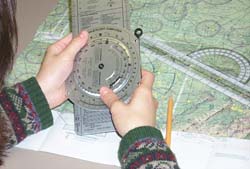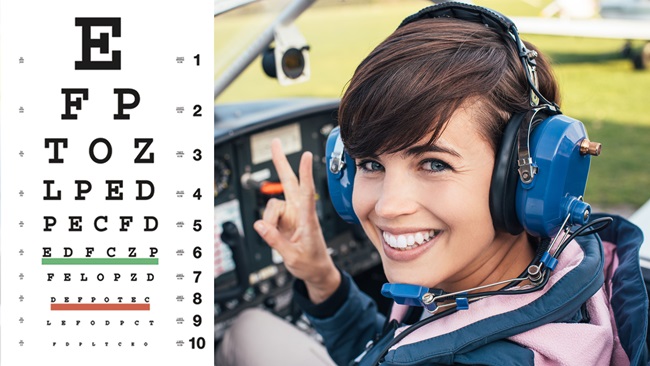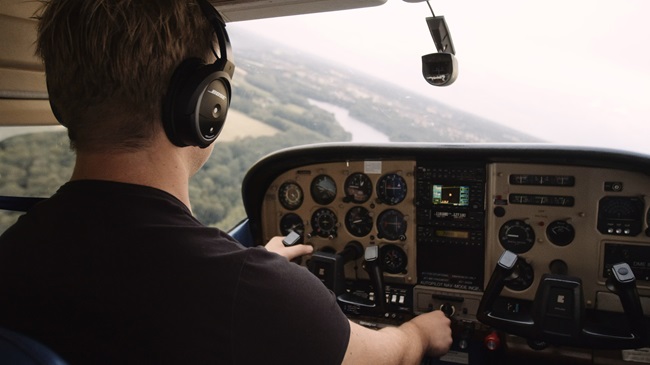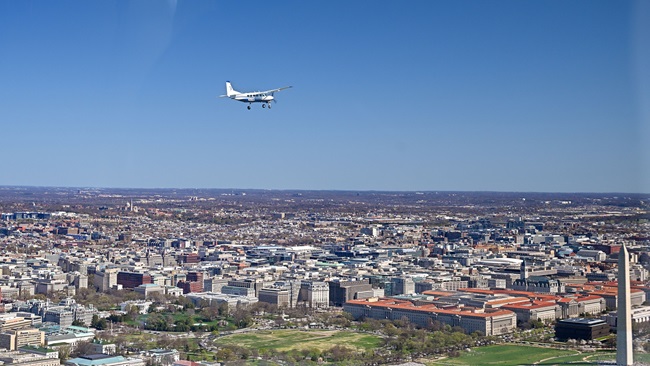| Advertisers
          
Do not reply to this e-mail. Got news? Contact ePilot. Having difficulty using this service? Visit the ePilot Frequently Asked Questions now at AOPA Online or write to [email protected].
Aircraft Owners and Pilots Association
421 Aviation Way
Frederick, MD 21701
Tel: 800/USA-AOPA or
301/695-2000
Copyright © 2003 AOPA. | Training Tips
| GRASPING GROUNDSPEED
Groundspeed-the rate of the airplane's in-flight progress over the ground-is a fundamental aeronautical concept. But not every student pilot understands this right away. Sometimes the sticking point is the realization that while an airplane moves "through" the air, it also moves "with" the air mass in which it flies.
Chapter 14 of the FAA's Pilot's Handbook of Aeronautical Knowledge, which you can download from AOPA Online, helps clarify: In a 25-knot wind from the north, "any inert object free from contact with the earth will be carried 25 nautical miles southward in one hour." Now imagine an airplane flying in that air mass: Its position after an hour results "from a combination of these two motions: the movement of the air mass with reference to the ground, and the forward movement of the airplane through the air mass."
 AOPA Flight Training Associate Editor Jill W. Tallman discusses applying groundspeed in the September 2002 issue's "Flying Smart" column. "This is the speed of your airplane relative to the Earth's surface. It's the speed that you'll use to calculate fuel burn and estimated travel times for each leg of your trip." Barry Schiff reviews how to determine groundspeed by using your flight computer to solve a wind triangle in "Whiz Wheel Wizardry," published in the April 2000 issue of AOPA Pilot magazine. AOPA Flight Training Associate Editor Jill W. Tallman discusses applying groundspeed in the September 2002 issue's "Flying Smart" column. "This is the speed of your airplane relative to the Earth's surface. It's the speed that you'll use to calculate fuel burn and estimated travel times for each leg of your trip." Barry Schiff reviews how to determine groundspeed by using your flight computer to solve a wind triangle in "Whiz Wheel Wizardry," published in the April 2000 issue of AOPA Pilot magazine.
Groundspeed plays a role in every approach and landing. Using the airport windsock or a wind report, we choose the runway that allows landing with the maximum possible headwind component, so the airplane's forward motion over the ground is as slow as possible when we're at our usual approach airspeed. This allows the shortest landing roll and minimum braking. As Ralph Butcher explains in the July 2002 AOPA Flight Training, "Your highest priority is an upwind landing with low groundspeed." This is true whether you're approaching a runway in normal operations or making an off-airport emergency landing.
Usually we calculate groundspeed from known true airspeed and wind data. But see how one pilot used known groundspeed to estimate airspeed after an airspeed indicator failure in the August 2002 installment of "Learning Experiences." Grasping these basic aeronautical concepts will help to bring mastery of safe and enjoyable flight.
| Your Partner in Training
| No person will be more influential in nurturing your desire to fly than your first flight instructor. A good flight instructor will make the flight training process enjoyable yet challenging, teaching you the intricacies of flight at a pace that is suitable to your schedule and level of learning. Begin your research by reviewing the AOPA Flight Training magazine archives for helpful articles on choosing an instructor. To find an instructor in your area, go to our searchable database of flight instructors.
As an AOPA Flight Training Member, you have access to all of the features within AOPA Online. For login information, click here.
| Flight Training News
| DANIEL WEBSTER ADDS HIGH-TECH TRAINERS
Daniel Webster College has acquired two Elite iGATE G500 advanced personal computer-based aviation training devices (PCATDs), which will be installed in January. The iGATE G500 qualified for advanced PCATD certification because it includes several enhancements from original PCATDs, including hardware that is upgraded to life-sized instruments and improved ergonomics. It permits users to log substantially more flight time for flight experience, as well as time toward instrument proficiency and recency of experience requirements. The college, located in Nashua, New Hampshire, also is acquiring a desktop version of the iGATE G500 that will allow students to practice procedures and skills in their free time.
STATE LAWMAKERS SEEK SMALLER TFRs
Pennsylvania lawmakers passed a resolution on Monday calling on federal officials to reduce the size of temporary flight restrictions (TFRs) resulting from presidential travel. The resolution, sponsored by Rep. Gene McGill (R-District 151), also calls for authorities to "reconsider the need to issue such restrictions based on nonspecific threats and ways to improve the timely dissemination of flight restriction information to pilots." Earlier this year a pipeline patrol pilot who unwittingly flew over the presidential motorcade in Philadelphia was intercepted by an F-16, forced to land, and questioned by the Secret Service before being released.
| Inside AOPA
| AOPA TAKES MESSAGE TO NTSB
AOPA President Phil Boyer and senior staff met with members of the National Transportation Safety Board last week to promote the association as an asset to NTSB when it has general aviation concerns. "Only one of the board members has any significant [general aviation] experience," Boyer said. "We wanted the other members to understand that there are often nonregulatory ways to improve safety, and that AOPA can help with pilot education." The purpose of the meeting was to drive home the point that AOPA and the Air Safety Foundation can respond to GA safety issues with programs that are effective at reducing the accident rate, Boyer said. "And we can do it quickly without the need for additional regulation."
Changing your mailing or e-mail addresses? Click here to update.
| Training Products
| 'FIRST FLIGHT' LETS YOU PILOT SIMULATED WRIGHT FLYER
Can't get to the Outer Banks next week to commemorate the centennial of powered flight? You might not be able to witness Ken Hyde's team from The Wright Experience recreate the first powered flight at Kill Devil Hills, North Carolina, but you can maneuver a computer-simulated replica of the 1903 Flyer that exhibits the same instability and marginal power as the original. First Flight: The Wright Experience also includes simulations of the Wrights' 1902 glider and the 1911 Model B, plus historically accurate flight environments including Kill Devil Hills; College Park, Maryland; and Fort Meyers, Virginia. The program requires Windows 98/2000/XP, Pentium III or higher processor, 64 MB RAM, video card capable of Direct-X 8.0 3-D acceleration, and sound card. It sells for $49.99 and may be ordered online.
| | Final Exam | Question: How do I go about getting a pilot certificate that does not use my Social Security number as the certificate number?
Answer: The FAA will assign a unique number to your certificate at your request. You will need to fill out the Airman's Request for Change of Certificate Number form and submit it to the FAA Airmen Certification Branch in Oklahoma City, Oklahoma. The FAA will assign a unique number to your certificate and reissue it. You can complete and print out the interactive form on the FAA Web site.
Got a technical question for AOPA specialists? E-mail to [email protected] or call 800/872-2672. Don't forget the online archive of "Final Exam" questions and answers, searchable by keyword or topic.
| Picture Perfect
| Only three more days to order a beautiful print from the AOPA Online Gallery for guaranteed holiday delivery! Of course, you can still download your favorite images to use for wallpaper or send a personalized e-card. For more details, see AOPA Online.
| What's New At AOPA Online
| Eric Plas of LaGrange, Ohio, had a chilly but memorable flight in a Waco open-cockpit biplane after his name was picked as a monthly winner in AOPA's Centennial of Flight Sweepstakes. Read about his experience online.
| Weekend Weather
| See the current weather on AOPA Online, provided by Meteorlogix.
| ePilot Calendar
| WEEKEND FLYING DESTINATIONS
Kill Devil Hills, North Carolina. A Centennial of Flight Celebration starts December 12 at First Flight (FFA). The celebration will culminate with the EAA's recreation of the most significant moment of the past 100 years-the Wright brothers' first powered flight on December 17. Dignitaries, celebrities, and aviation legends will be on hand to celebrate and commemorate this occasion. Tickets for December 17 activities are sold out-for more information, visit the Web site.
To submit an event to the calendar, or search all events, visit AOPA Online. For airport details, see AOPA's Airport Directory Online .
ASF FLIGHT INSTRUCTOR REFRESHER CLINICS
The next AOPA Air Safety Foundation Flight Instructor Refresher Clinics are scheduled in San Jose, California, and Portland, Oregon, January 3 and 4. Clinics are also scheduled in Detroit; Knoxville, Tennessee; and Seattle; January 10 and 11. For a complete schedule, see AOPA Online. Can't make it in person? Sign up for the CFI Renewal Online.
ASF PINCH-HITTER GROUND-SCHOOL COURSES
The next Pinch-Hitter® Ground Schools take place in Portland, Oregon, January 4, and Charlotte, North Carolina, January 25. For more Pinch-Hitter courses, see AOPA Online.
ASF SAFETY SEMINARS
AOPA Air Safety Foundation Safety Seminars are scheduled in Reno, Nevada, January 5; Sacramento, California, January 6; Santa Rose, California, January 7; Oakland, California, January 8; and San Jose, California, January 9. The topic is Maneuvering Flight-Hazardous to Your Health? For complete details, see AOPA Online.
| |












 AOPA Flight Training Associate Editor Jill W. Tallman discusses applying groundspeed in the September 2002 issue's
AOPA Flight Training Associate Editor Jill W. Tallman discusses applying groundspeed in the September 2002 issue's 

